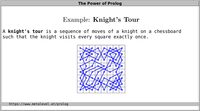Prolog is a programming language that is rooted in formal logic. It supports search and unification as built-in features. Prolog allows us to elegantly solve many tasks with short and general programs.
The goal of this material is to bridge the gap between the great traditional Prolog textbooks of the past and the language as it currently is, several decades after these books were written. You will see that many limitations of the past are no longer relevant, while several new constructs are now of great importance even though they are not yet covered in any available Prolog book.
This book is self-hosting: It includes an HTTP server that lets you browse most of the content locally. When you access files that are not locally available, it redirects to their online versions.
You need Scryer Prolog to run it. For example, to spawn the server on port 6012, use:
$ scryer-prolog -g "server(6012)" server.pl
Then, direct your browser to:
If you are new to Prolog, read the chapters in order for a self-contained exposition of many important language features. If you already have some experience with Prolog and would like to learn more about more recent aspects, I recommend you start with the chapter on integer arithmetic and proceed with the chapters it links to.
The latest version of this book is always available from:
https://www.metalevel.at/prolog
I will periodically synch this repository with new material as it becomes available.
I started writing this book in 2005, when I was a student of Ulrich Neumerkel in Vienna. A collection of Prolog meta-interpreters formed the first chapter.
To run the code examples, you can use every Prolog implementation that conforms to the Prolog ISO standard and provides the following conforming extensions:
- Definite Clause Grammars (DCGs)
- constraints like
dif/2and declarative integer arithmetic - alternative execution strategies such as SLG resolution.
A conforming extension is a language feature that would not cause any ambiguity or contradiction if it were added to the Prolog standard, ISO/IEC 13211. Notably, a conforming extension must not change the meaning of Prolog text which conforms to the standard. Each of the above features can be added to every Prolog system in a conforming manner, as exemplified by the following recommended Prolog systems:
- SICStus Prolog A state-of-the-art, ISO standard compliant, Prolog system.
- Scryer Prolog A modern Prolog implementation written mostly in Rust.
- GNU Prolog A free Prolog compiler with constraint solving over finite domains.
In the example code, I assume that the Prolog flag double_quotes is
set to the value chars so that strings in double-quotes are
interpreted as lists of characters. This was the case in the
original Prolog implementation, Marseille Prolog, and is already the
default value in the four newest Prolog implementations,
Scryer Prolog,
Tau Prolog,
Trealla Prolog and
ichiban/prolog. It is to be hoped
that other Prolog systems will also adopt this setting to make
string processing with Prolog more convenient.
In some cases, slight modifications to code snippets may be necessary
to adjust for different libraries or small variations. See your Prolog
system's manual, or ask on Stackoverflow and comp.lang.prolog
for more information.
Prolog is an interesting programming language: It has a pure monotonic core, and it also has features that are called impure. You, the programmer, must decide in which subset of the language you want to program.
In a sense, programming in Prolog is like writing a poem: You can achieve great effects by writing under stringent constraints. In Prolog, you often get the best results by restricting your work to the pure core of the language. As long as you do this, you can benefit from strong logical properties which let you reason about your programs in systematic ways that are not available in most other programming languages.
In the past decades, many pure features have become widely available in Prolog systems. This book explains many of these new features, and shows you how you can use them to achieve general and efficient Prolog programs.
Currently, new pioneers are arising: The first instructors who use this book in their courses! For example:
- As of 2018, Norbert Zeh is using The Power of Prolog in CSCI 3136: Principles of Programming Languages at Dalhousie University in Canada.
- As of 2018, Andrej Bauer is using The Power of Prolog in his specialist elective course Principles of Programming Languages at the University of Ljubljana in Slovenia.
- As of 2018, José A. Alonso Jiménez is using The Power of Prolog in his Seminario de Lógica Computacional at the Universidad de Sevilla in Spain.
- As of 2019, Adam Dingle is using The Power of Prolog in Non-Procedural Programming at Univerzita Karlova in the Czech Republic.
- As of 2019, Dylan Schwesinger is using The Power of Prolog in Artificial Intelligence II at Kutztown University in the United States of America.
- As of 2020, Andrea Schwertner Charão is using The Power of Prolog in Paradigmas de Programação at the Federal University of Santa Maria in Brazil.
- As of 2020, Alejandro Guerra Hernández is using The Power of Prolog in Programación para la Inteligencia Artificial (PIA) at the Universidad Veracruzana in Mexico.
- As of 2021, Ilkka Kokkarinen is using The Power of Prolog in CCPS 721 Artificial Intelligence I at the G. Raymond Chang School of Continuing Education, Ryerson University, in Canada.
- I hope you are next!
Le message dur: Restez purs!
